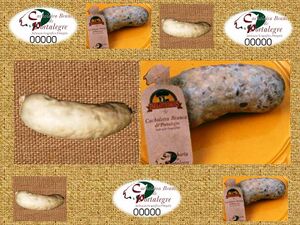Cacholeira Branca de Portalegre (Portalegre white sausage)

IGP Cacholeira Branca de Portalegre is a sausage obtained principally from the fat, the liver and other organs of the Alentejo pig which is a Mediterranean breed. This steamed sausage consists primarily of salted liver and other internal organs (spleen, heart and pancreas) and soft fat from Alentejano pigs, sometimes with crushed ungerminated dried garlic and caraway seeds. The casing is of natural dried intestine; only the small and large intestine of pigs is used. The sausage is horseshoe-shaped, cylindrical, twisted or tied and measuring up to 50 cm. It is dark chestnut brown, shiny grey and semi-hard; the case is unbroken and adheres closely to the content. It is between 30 and 50 mm in diameter. Cut, the sausage reveals a uniform perfectly adhering, marbled content, and with a variety of chestnut grey tones. It is has a unique pleasant, smooth or delicate taste and is slightly salty. It has a pleasant unique aroma. The fat is shiny and pearly white, of pleasant smell and taste. The consistency varies depending on the feed and percentage of acorns eaten by the Alentejano pigs.
Geographical area:
The taste of the product, the soil and climate required for its production and the local, correct and consistent methods mean that the geographical area of production is restricted to the municipalities of Alter do Chão, Arronches, Avis, Campo Maior, Castelo do Vide, Crato, Elvas, Fronteira, Gavião, Marvão, Monforte, Nisa, Ponte de Sor, Portalegre and Sousel in the district of Portalegre in Portugal.
Proof of origin:
The Cacholeira Branca de Portalegre may be produced only on authorized premises situated in the geographical area outlined. The raw material comes from Alentejano pigs reared extensively or semi-extensively in the open air under hill conditions (feed based on grass and acorns) in the Alentejo. An inspection system ensures that the whole production process can be traced. The fame of the cooked meat products produced in the Portalegre area is attested by a reference in a parish record of 1750.
Method of production:
The fat, liver and other internal organs obtained from the slaughter of Alentejano pigs reared as described above are cut in the traditional way ("miga"), seasoned, stuffed, boiled and dried, so acquiring the appearance, colour, taste and aroma characteristic of the Cacholeira Branca de Portalegre. Processing is carried out in a natural environment in accordance with local, correct and consistent practice.
Link:
The region of Portalegre has its own micro-climate providing special conditions for the production of cooked meats (cold dry winters). Because of the constant supply of Alentejo pork resulting from the particular conditions under which these animals are raised, local inhabitants developed special techniques for preserving it and developing its particular taste either by using very simple flavourings based on regional products or by smoking with local wood. This gives the Cacholeira Branca de Portalegre its special appearance, taste and aroma and its unmistakable links with the area.
Gastronomy:
IGP Cacholeira Branca de Portalegre must be stored in a cool place where the temperature remains between 5°C and 10°C. This sausage is normally eaten as a starter or as an accompaniment to the many local dishes of the Alentejo region.
Reference: The European Commission
#fat #sausage #liver #dried #garlic #heart #meats #accompaniment #portugal #carawayseeds #starter